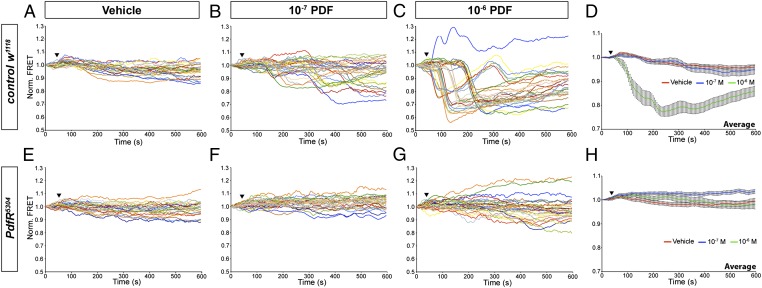Fig. 4.
PDF causes cAMP increases in ureter muscles. Epac1-camps FRET imaged from the ureter muscles of adult male Drosophila. Decreases in YFP/CFP FRET indicate increases in cAMP. (A–C) The responses of wild-type (w1118) male ureter muscles to vehicle (0.1% DMSO), 10−7 M PDF, and 10−6 M PDF, respectively. The data for 10−6 and 10−7 M are based on six ureters from six w1118 flies with five regions of interest (ROIs) per ureter. The data for vehicle controls are based on five ureters from five flies with five ROIs per ureter. (D) Mean normalized FRET responses for the traces shown in A–C. The FRET values for the 10−6 M PDF treatment were significantly different from vehicle controls after 110 s (P < 0.001). No significant differences were observed between the vehicle and the 10−7 M PDF, although several individual muscles responded to this dose (B). (E–G) Responses of PdfR5304 mutant ureter muscles to vehicle, 10−7 M PDF, and 10−6 M PDF, respectively. The data for the 10−6 and 10−7 M PDF treatments are based on six ureters from six flies with five ROIs per ureter. The data for vehicle controls are based on five ureters from five flies with five ROIs per ureter. (H) The average normalized FRET responses for the traces shown in E–G. For PdfR5304 ureter muscles, neither peptide dose caused significant FRET changes compared with vehicle. There was a significant difference between PdfR5304 and w1118 when treated with 10−6 M PDF. By 115 s, the FRET ratios of w1118 ureter muscles were significantly lower than those of PdfR5304 (P < 0.001). In graphs D and H the error bars = SEM calculated from all muscles at each timepoint. Black triangles indicate time of bath application.

